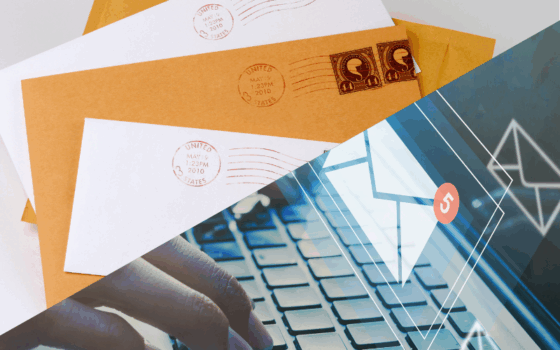What is a Mailshot?
Mailshot is a term often used by businesses when discussing marketing campaigns or customer communications. But what is a Mailshot and how can they benefit your business?
A mailshot is a form of direct marketing used to contact a large group of prospective or existing customers. From direct mail to e-shots, there are a number of approaches to mailshot campaigns that your business or organisation may take, depending on what is best suited to your target audience.
Mailshots can be sent in different formats with popular options including letters, postcards, flyers and emails. The format may be decided depending on the offer or information that you’re trying to communicate with your customers, and which platform and mail type would best suit the needs of the campaign.
What are the benefits of Mailshots?
Mailshots are a proven direct marketing method that many businesses use to promote their brand, products, or services.
For instance, B2C businesses often use mailshots to promote consumer goods and seasonal discounts, leveraging eye-catching visuals and offers to drive immediate action. In contrast, B2B companies might use mailshots to send personalised information about services or invite key decision-makers to exclusive events, focusing on building long-term relationships and trust. The strategy behind each varies depending on the target audience and objectives.
According to Dr. Sarah Thompson, a marketing professor at the University of London, ‘Direct mail has a unique advantage in that it creates a more personal interaction between a brand and a consumer. Unlike emails that may be filtered into spam or deleted quickly, a well-crafted piece of mail is often held onto, creating long-lasting impact.’ This insight is especially important when considering how direct mail can be a key element in a comprehensive marketing strategy.
High response rates:
Academic studies, such as a 2020 report by Marketreach, have shown that 87% of people asked say they trust direct mail more than any other marketing channel. Whilst this 2021 report from DMA shows that response rates from direct mail campaigns are around 9%, with 91% of consumers engaging with physical marketing materials.
Integrated marketing:
When used in conjunction with other marketing channels, mailshots have a proven track record of boosting the effectiveness of promotional campaigns by reinforcing your messaging through physical media
Highly cost effective:
Compared with digital advertising, mailshots campaigns offer a far more cost-effective method of promoting your products or services, as well as offering a higher ROI.
For example, let’s say you send out 1,000 direct mail postcards for £500. If 50 recipients respond and make a purchase worth £20 each, your total revenue from the mailshot is £1,000. Your ROI for this campaign would be calculated as follows:
(Revenue – Cost of Campaign) ÷ Cost of Campaign = ROI
(£1,000 – £500) ÷ £500 = 100% ROI.
By understanding how to calculate ROI, you can better measure the effectiveness of your mailshot campaigns and make data-driven decisions for future marketing strategies.
Increase Brand Awareness:
As direct mail is delivered straight into the hands of your customers, it creates an immediate and tangible interaction with your brand and is therefore far more likely to resonate with your target audience
Highly targeted:
With a clear understanding of your audience, you can generate bespoke mailing lists and personalised messaging to target key stakeholders and customer groups
Mailshots help to support your wider marketing strategy and campaigns across other channels, such as on social media or on your website itself
What are mailshots used for?
You can use mailshots for a variety of reasons, some of the most common uses from businesses include:
- Launching a new product or service
- Promoting an existing product or service
- Increasing website traffic
- Expanding brand awareness
- Supporting a wider digital marketing campaign
- Building relationships with existing customers

How to create a mailshot?
Creating an effective mailshot campaign can be difficult, it’s important to first establish your target audience. Think about your ideal demographic in terms of age, gender and interests and tailor your mailshot in a way that speaks to that particular demographic. This could be through the style you use, the overall wording and the final call to action.
Our in-house team of mailshot experts are on hand to help, we can help your business come up with a defined approach and execute it in a way that will provide a high ROI. We also have a team of designers on hand to bring your message to life and promote your brand through powerful communications.
Common Mistakes to Avoid in Mailshot Campaigns:
- Not targeting the right audience – Ensure that you segment your list and tailor your message to specific customer groups.
- Weak or unclear call to action – Make it easy for the recipient to take action, whether that’s visiting your website, calling you, or signing up for a newsletter.
- Ignoring the design – A cluttered or poorly designed mailshot is less likely to be noticed. Ensure your message is clean, simple, and visually appealing.
What’s an example of a successful mailshot?
A good mailshot campaign should have been well thought out and contain a clear message and call to action. It’s best to provide multiple call to actions such as an email address, phone number and website URL so that the recipient can get in touch in a way that best suits them. Incentives are also a good way to increase the response rate from your mailshot, whether this is by offering a discount code or even a prize to try and get people involved.
According to leading e-mail marketing giant, MailChimp, you can see up to 88% more revenue by targeting your most valuable customers with predicted segments. With the option to create predefined segments, or allow automated segments to generate based on user interactions, you can accurately respond to your customer’s journey, rather than just their basic demographics. The same is true for direct mail, you can use automation to track responses and sales, allowing you to tailor your campaigns to make them more relevant.
To personalise your mailing list effectively, segment your customers based on criteria such as purchase history, geographic location, or behavior on your website. For example, if you run a clothing store, you could send different offers to customers who have previously bought men’s clothing versus women’s clothing. This type of segmentation makes the campaign more relevant and increases the likelihood of a response.
Direct Mail vs Email

Though direct mail remains a powerful tool, it is essential to recognise that email marketing also offers significant advantages. For instance, email campaigns can be more cost-effective for immediate promotions and offer detailed metrics on engagement, such as open rates and click-through rates.
Using email alongside direct mail can strengthen your overall campaign by combining the immediate impact of email with the lasting memory created by physical mail. Both approaches have their strengths, and a combination of the two can often yield the best results.
Direct mail does continue to outperform email in certain areas due to its tactile nature. According to a 2018 report by the Data & Marketing Association (DMA) UK, 62% of consumers reported that they read direct mail more than once, compared to just 33% for emails. This indicates that direct mail is more likely to create a lasting impression and be retained for future reference.
Moreover, a Marketreach study revealed that 87% of UK consumers stated that they had been influenced to make online purchases after receiving direct mail. These findings underscore the effectiveness of direct mail in driving customer action, particularly when used alongside digital marketing strategies.
This is not to say that you should avoid email campaigns altogether. The power of email marketing, or e-shots, lies in its ability to reach your target audience almost instantaneously, as well as provide valuable data on how your audience engages with your content. E-shot campaigns can also be a highly effective way of driving traffic to your website and helping to improve your SEO efforts. When used in conjunction with direct mail, a well-planned and executed e-shot can reinforce your promotional campaign.
However, it seems digital fatigue has been encroaching into the lives of the modern consumer. One in five people surveyed admitted to needing a ‘digital detox’, with 70% of people looking to reduce their overall consumption of digital media. In a world saturated by social media, spam emails, and pop-up ads, your e-shot could be just another digital distraction wilfully ignored by your target audience. Coupled with the heightened GDPR regulations now governing electronic communications, as well as the ever-restrictive spam filters, direct mail has become a far more effective method of reaching your audience than emails alone – providing a longer-lasting, meaningful interaction with your brand.
Mailshots provide opportunities to cross-sell
Cross-selling is the practice of offering related products or services to existing customers. For example, if a customer has purchased a pair of shoes, you might offer them socks or shoe polish. Since these customers already trust your brand, they are more likely to make additional purchases.
A Direct mail campaign to your established customer base is a powerful medium for cross-selling, particularly as a significant number of households end up purchasing as a result of receiving direct mail. That, coupled with the impressive response rates associated with direct mail, makes it one of the most effective avenues for generating further business.
With approximately 75% of the cost of direct mail being attributed to postage, a well-designed direct mail pack can maximise its value by incorporating promotional materials for additional products or services. If you need to send out a standard customer communication, why not include a flyer for your latest promotion, or more information about your other products without paying any additional postage?
How to send a mailshot?

With enough staff, the right equipment to create the style and finish you want, and the facilities to manage high-volume direct mail campaigns, it’s perfectly feasible to manage your mailshots in-house. However, sending bad mailshots can be worse than sending no mailshots, so you need to make sure you know what you’re doing before you choose this option.
Alternatively, you can save yourself the hassle of managing your mailshots by outsourcing this to a company with the resources and expertise to deliver and manage market-leading mailshot campaigns.
At Integrity Connect, we use cutting-edge document composition software to create highly personalised communications. This allows us to optimise content delivery across various channels, including direct mail and email.
While we believe in the effectiveness of this approach based on our experience with numerous clients, we encourage businesses to evaluate their options and choose a solution that best fits their unique needs. Our approach delivers measurable results that drive brand engagement.
We provide 100% mailing service for clients sending out high volume direct mail work, and offer unrivalled firepower for the production of direct mail stationery and inserts.
We pride ourselves on working closely with our clients to ensure that their campaigns reach their target audience through the ideal channel – be it direct mail, email, or SMS – all the while maintaining consistent branding and tone of voice.
Ready to launch your next mailshot campaign? Contact our team of experts today to create a personalised, high-impact marketing strategy tailored to your business goals.





